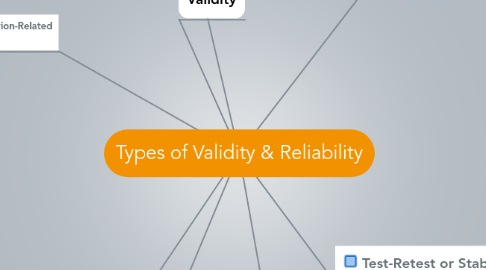
1. Internal Consistency
1.1. If a single concept is being tested, it can be assumed that if they get one question right they will probably get similar questions right as well
1.2. Items need to be correlated with each other, and the test should be internally consistent.
2. Concurrent Criterion-Related Validity Evidence
2.1. Deals with measures that can be administered at the same time as the measure to be validated
2.2. Yields a numeric value, which is simply a correlation coefficient
2.3. Correlation coefficient is called the validity coefficient when it is used to illustrate validity evidence
2.4. Measures the relationship between measures made with existing tests. The existing tests are the criterion.
3. Content Validity Evidence
3.1. Inspect test questions to see whether they correspond to what the individual decides should be covered on the test
3.2. Easiest to see when the test in is an area such as achievement
3.3. More difficult if the test is a personality or aptitude trait test.
3.4. Gives information about if the test looks valid but does not tell if the reading level is too high or if the items are poorly constructed.
3.5. Content validity evidence is more of a minimum requirement for a useful test than it is a garuntee of being a good test.
4. Validity
5. Reliability
5.1. 2.4 Progress Control
5.1.1. Update Project Schedule
5.1.2. Update Budget / Costs
5.1.3. Conduct Team Status Review
5.1.4. Create Status Report
5.2. 2.5 Change Control
5.2.1. Request Changes
5.2.2. Identify Alternative Solutions
5.2.3. Conduct Steering Committee Meeting
5.2.4. Document Change Responses
5.2.5. Implement Change(s)
5.3. 2.6 Issues Management
5.3.1. Identify Project Issues
5.3.2. Assess Impact of Issues
5.3.3. Assign Resources
5.3.4. Resolve Issue
5.4. 2.7 Stage Closure Assessment
5.4.1. Determine Next Stage Tasks
5.4.2. Determine Task Dependencies
5.4.3. Estimate Effort
5.4.4. Allocate Resources
5.4.5. Prepare Next Stage Schedule
5.4.6. Prepare Next Stage Budget
5.4.7. Update Project Schedule
5.4.8. Update Project Budget
5.4.9. Review Business Case
5.4.10. Review Project Organization
5.4.11. Review Project Scope
5.4.12. Prepare Stage Assessment
5.4.13. Review Stage Assessment
5.4.14. Follow-Up Stage Assessment
5.4.15. Compile Stage Closure Report
